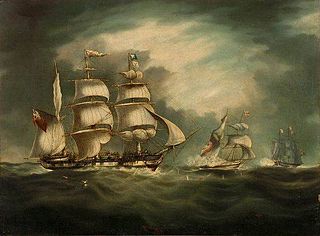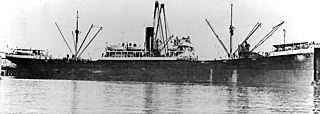
USS Wasp of the United States Navy was a sailing sloop-of-war captured by the British in the early months of the War of 1812. She was constructed in 1806 at the Washington Navy Yard, was commissioned sometime in 1807, Master Commandant John Smith in command. In 1812 she captured HMS Frolic, but was immediately herself captured. The British took her into service first as HMS Loup Cervier and then as HMS Peacock. She was lost, presumed foundered with all hands, in mid-1814.

USS Syren was a brig of the United States Navy built at Philadelphia in 1803. She served during the First Barbary War and the War of 1812 until the Royal Navy captured her in 1814. The British never commissioned her but apparently used her for a year or so as a lazaretto, or a prison vessel. She then disappears from records.
USS Gallatin (1807) was a post-Revolutionary War sailing vessel that the U.S. Department of the Treasury purchased at Norfolk, Virginia, for the United States Revenue-Marine in December 1807. An explosion on board destroyed her in 1813.

HMS Belle Poule was a Royal Navy fifth-rate frigate, formerly Belle Poule, a Virginie-class frigate of the French Navy, which was built by the Crucy family's shipyard at Basse-Indre to a design by Jacques-Noël Sané. She was launched on 17 April 1802, and saw active service in the East, but in 1806 a British squadron under Sir John Borlase Warren captured her off La Palma in the Canary Islands. The Admiralty commissioned her into the Royal Navy as HMS Belle Poule. She was sold in 1816.

USS West Carnifax (ID-3812) was a cargo ship in the United States Navy shortly after World War I. After she was decommissioned from the Navy, the ship was known as SS West Carnifax, SS Exford, and SS Pan Royal in civilian service under American registry.

HMS Sophie was an 18-gun Cruizer class brig-sloop of the Royal Navy. She served during the Napoleonic Wars and the War of 1812. During the War of 1812 Sophie participated in the economic war against American trade, capturing or destroying numerous small merchant vessels, and in an unsuccessful attack on Fort Bowyer, Alabama. Later, she moved to the East Indies where she served in the First Anglo-Burmese War. The Admiralty sold Sophie in 1825.

Sunny South, an extreme clipper, was the only full-sized sailing ship built by George Steers, and resembled his famous sailing yacht America, with long sharp entrance lines and a slightly concave bow. Initially, she sailed in the California and Brazil trades. Sold in 1859 and renamed Emanuela, she was considered to be the fastest slaver sailing out of Havana. The British Royal Navy captured Emanuela off the coast of Africa in 1860 with over 800 slaves aboard. The Royal Navy purchased her as a prize and converted her into a Royal Navy store ship, Enchantress. She was wrecked in the Mozambique Channel in 1861.
Guiding Star was a 7,248 GRT troopship that was built in 1939 as the Type C2 cargo ship Nightingale by Newport News Shipbuilding & Dry Dock Co, Newport News, Virginia, United States for Grace Lines Inc, New York. In 1941, she was transferred to the Ministry of War Transport (MoWT) and renamed Empire Egret. In 1942, she was transferred to the United States Maritime Commission (USMC) and renamed Nightingale. She was returned to Grace Lines later that year and renamed Santa Isabel. In 1943, she was converted to a troopship. She was transferred to the USMC in 1946 and renamed Guiding Star, serving until she was scrapped in 1973.
Coromandel was the French prize Modeste, captured in 1793 and refitted at Chittagong, British India. She made two voyages transporting convicts to Port Jackson, the first for the British East India Company (EIC). A French privateer captured her in 1805 but she had returned to British hands before 1809. An American privateer captured her in 1814 but this time the British Royal Navy recaptured her within days. She foundered in Indian waters on 6 February 1821.
Surprise was a highly successful American privateer schooner. She was launched in 1813 and operated out of Baltimore. She captured over 40 British vessels during her brief career. In one case the capture followed a single-ship action. She was wrecked in April 1815, shortly after the end of the War of 1812.
Albion was launched at Topsham, Devon, in 1800. She spent most of her career sailing between London and Jamaica. After 1814 she held a license from the British East India Company to trade with India, but she does not appear to have availed herself of the option. In 1814 the American privateer Brutus captured Albion, but the British recaptured her within a few days. She was condemned at Charleston, South Carolina, and broken up in 1816.
A number of ships have been named Timandra for the mythological Timandra:
Paragon was launched at Lancaster in 1801, or 1800. She traded across the Atlantic with the West Indies, South America, and North America. She captured one French vessel, and was herself captured, but swiftly recaptured by the Royal Navy. She was last listed in 1830, but with stale data from 1825.
Several ships have borne the name Cambridge for Cambridge:
Several ships have been named Ceres for Ceres, the Roman goddess of agriculture:
Lord Wellington was launched in 1812 in Quebec, possibly in Montreal. She was a London-based transport that made one voyage to India in 1819 under a license from the British East India Company (EIC). Afterwards she continued to sail to the Baltic and North America. She was last listed in 1829.
Several ships have been named Woodlark after the woodlark:
Grace was launched in New York in 1812. She was taken in prize circa 1814. She then became a Falmouth, Cornwall, packet, sailing for the Post Office. She primarily sailed to New York via Halifax and Bermuda, but also sailed to the Mediterranean and Brazil. She twice encountered American privateers, repelling one and outpacing the other. In 1821 she sailed on a seal and whale hunting voyage to the South Shetland Islands and the coast of Chile. She foundered in the South Atlantic circa May 1823 while homeward bound.





